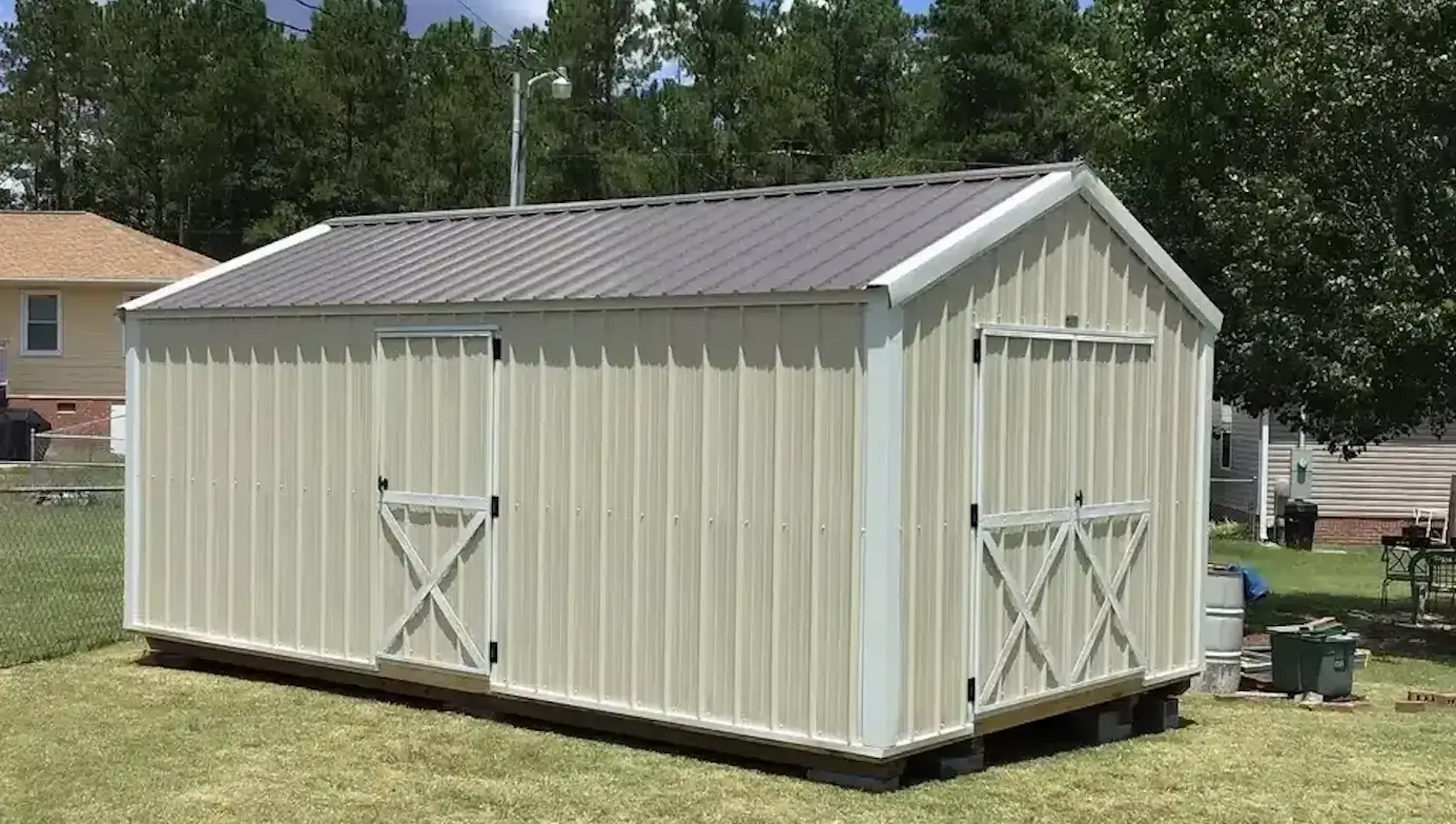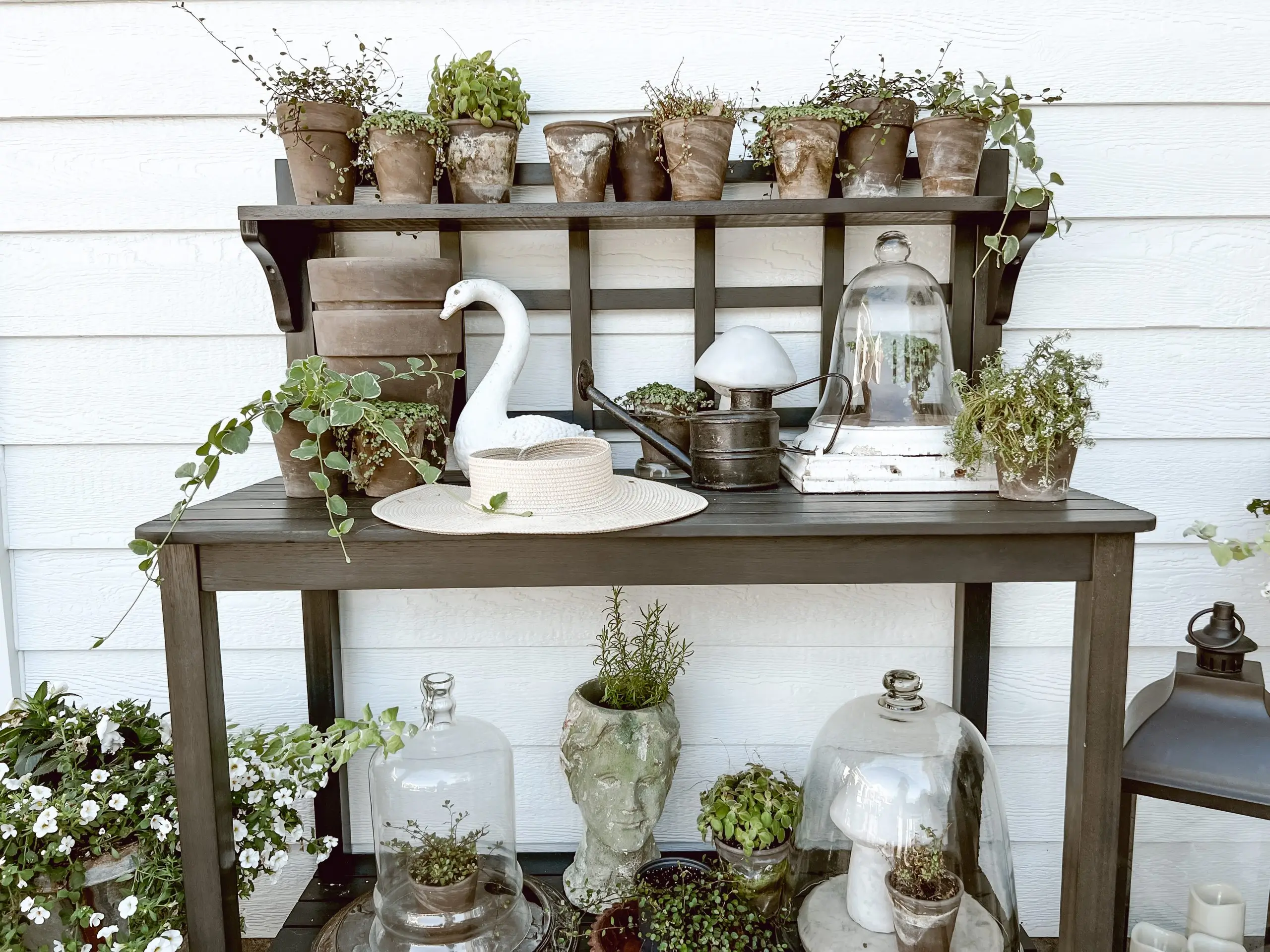- A potting bench creates a focused area for potting plants and other gardening activities, making gardening more practical and organized.
- The perfect potting bench includes a spacious work area, storage spaces, an ergonomic work surface, and easy cleaning features.
- Potting benches come in various designs, from rustic outdoor tables to modern indoor stations, to suit different spaces and needs.
Gardening not only can be a fun and enjoyable activity, but it can also be a frustrating one if you don’t have the proper tools and workspace. If you love gardening, then a potting bench really does make life so much easier and more enjoyable for the gardener. A potting bench, though, is a specific work area where gardeners do things like repotting plants, planting seeds and putting away garden tools. Without the right area to work on, such tasks can make a mess and often take longer, causing frustration and clutter in the garden.
A potting bench has a spacious work top area with enough storage space for all your needs, making it easy to get your work done with no obstructions. It keeps gardeners on task rather than scrambling for tools or making several trips back and forth when they need something.
MEET THE EXPERT
- ■
Marcus Bridgewater is a well known gardening guru, author and wellness proponent who highlights the psychological, physical and spiritual betterment through gardening on his social media platforms.
- ■
Adam Kirtland is a gardening expert, writer and podcaster who’s known for his fantastic content as well as his appearances on the gardening circuit, where he shares some of his best advice on potting benches and plant care..
Potting Bench Features
There are several important features to look for when selecting a potting bench that will suit the gardener and one that will be as functional as possible. Here are some of the key features to look for in a high-quality potting bench:
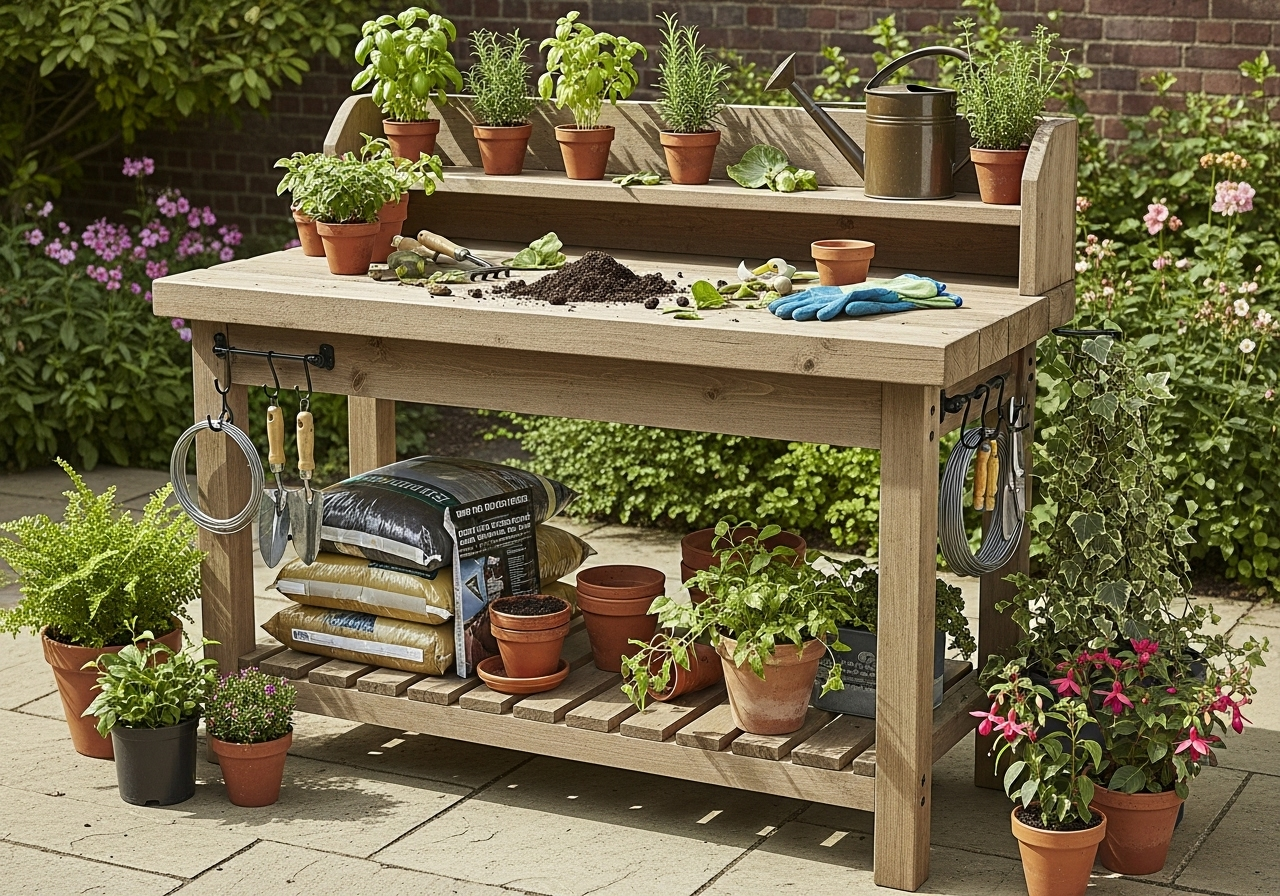
- Sturdy Work Surface: A bench must be able to support mixing soil or setting pots. They are made of durable wood, metal, or composite materials.
- Adequate Storage Space: A quality potting bench offers ample storage, including shelves, drawers, and hooks to keep tools, pots, and other gardening supplies within easy reach. It keeps the work area clean and tools always within easy reach.
- Ergonomic Height: The bench height must allow the user to work without bending or hunching. An ergonomic height allows gardening for more time with less strain on the body.
- Drainage Options: Certain potting tables come with built-in sinks or draining mechanisms, so excess water can flow away instead of spilling on the ground. This is particularly important in order to keep the area tidy and to prevent any water damage.
- Weather Resistance: When choosing outdoor potting benches, users should look for waterproof and weatherproof designs. Wood should be treated to resist rot, and metal surfaces must be rustproof for durability.
- Compact Design: For small space gardeners, a small potting bench is the perfect choice. These benches are specifically constructed to provide all the basics in a more petite, space-saving design, ideal for compact gardens or indoors.
Styles of Potting Benches
There are different styles of potting benches to suit a range of space, aesthetic and functional needs.
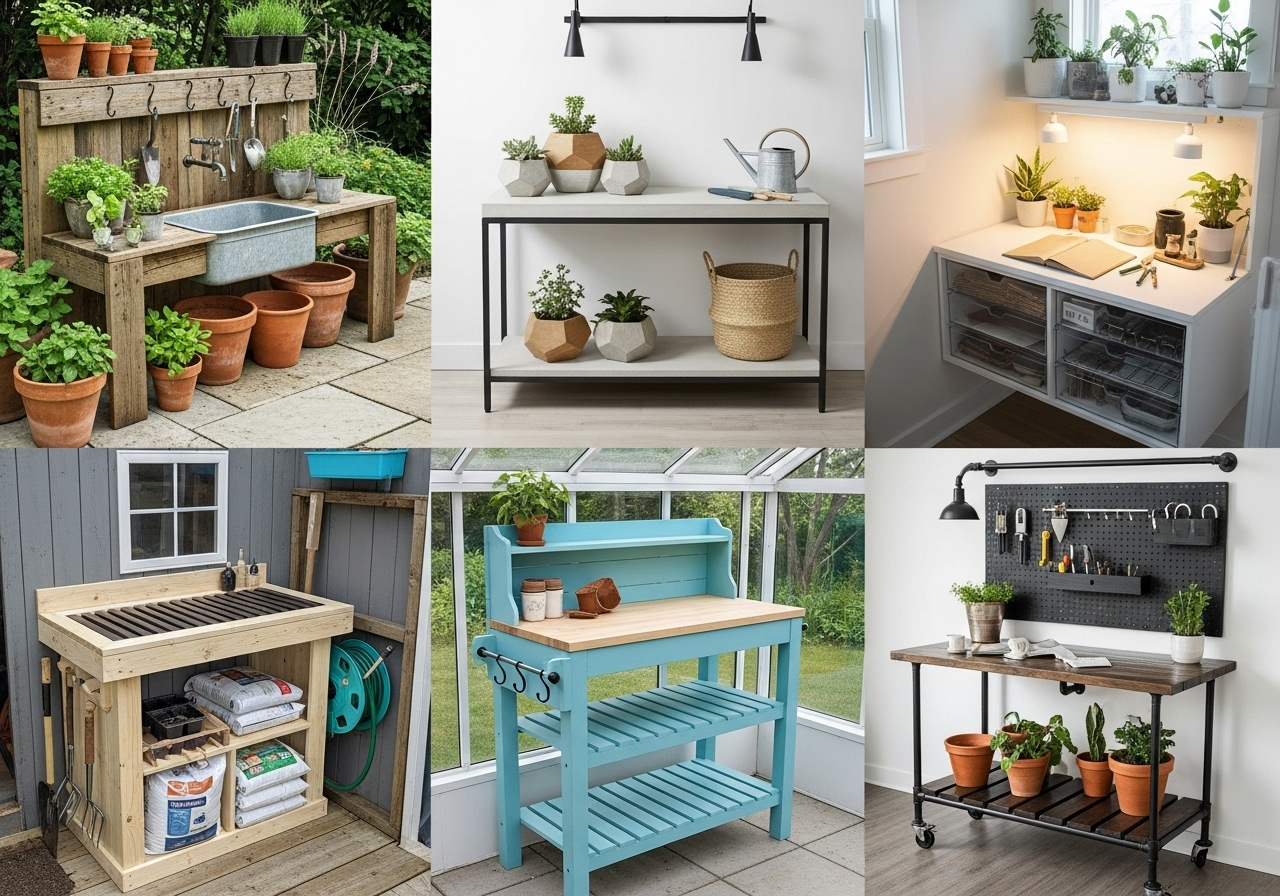
Rustic Outdoor Benches
Rustic outdoor potting benches for gardens, patios and backyards are available in any size, height or shape, and can be more or less elaborate depending on the need.
- This is generally in the form of weathered or unstained wood to complement the outdoor look.
- Wide, open shelves for plenty of storage space for gardening and planting equipment, soil and pots durable construction to withstand the elements.
- Some come with separate built-in sinks, making watering and cleaning even more convenient.
- It's perfect for gardeners who like a timeless, classic look that showcases the natural surroundings.
Modern Minimalist Designs
Today’s minimalist potting benches are sleek, featuring clean lines and prioritizing function over form.
- Constructed from metal, stainless steel or treated wood, these benches have a sleek, modern look.
- Sometimes tiny, they make the most of a small space with a stylish look, perfect for urban gardens, balconies, or patios.
- They are super height-adjustable, have secret drawers, can come in a super convenient height from floor to working area and have minimalistic hooks designed specifically for tools.
- Useful to people who would like to have a modern and functional gardening space.
Compact Indoor Potting Stations
Small indoor potting stations are great for limited space or for indoor gardeners.
- These benches are small enough for a garage, balcony, or even an indoor garden.
- Even though they are more compact in size, they feature shelves, work surfaces and hooks to help streamline the gardening process.
- Great for growing herbs, seedlings and small plants, it enables indoor gardening to be done throughout the season, no matter how cold or warm it gets.
- Some models are built with waterproof surfaces or a tray to maintain the area clean and dry.
ℹ
Custom-Built vs. Pre-Made Options
Custom-Built: Fully customizable so gardeners can choose the materials, size, and features tailored to their gardening needs. However, they can be costly and take time to develop.
Pre-Made: Pre-made potting benches are ready to use right out of the box, and come in dozens of styles and sizes for a quick solution. But they won't have the same variety and customization as custom-built pieces.
Storage Solutions for Potting Benches
The best potting bench with storage makes it easy to access tools and supplies and also makes the most of limited space. Here are some storage solutions to look for in a potting bench:
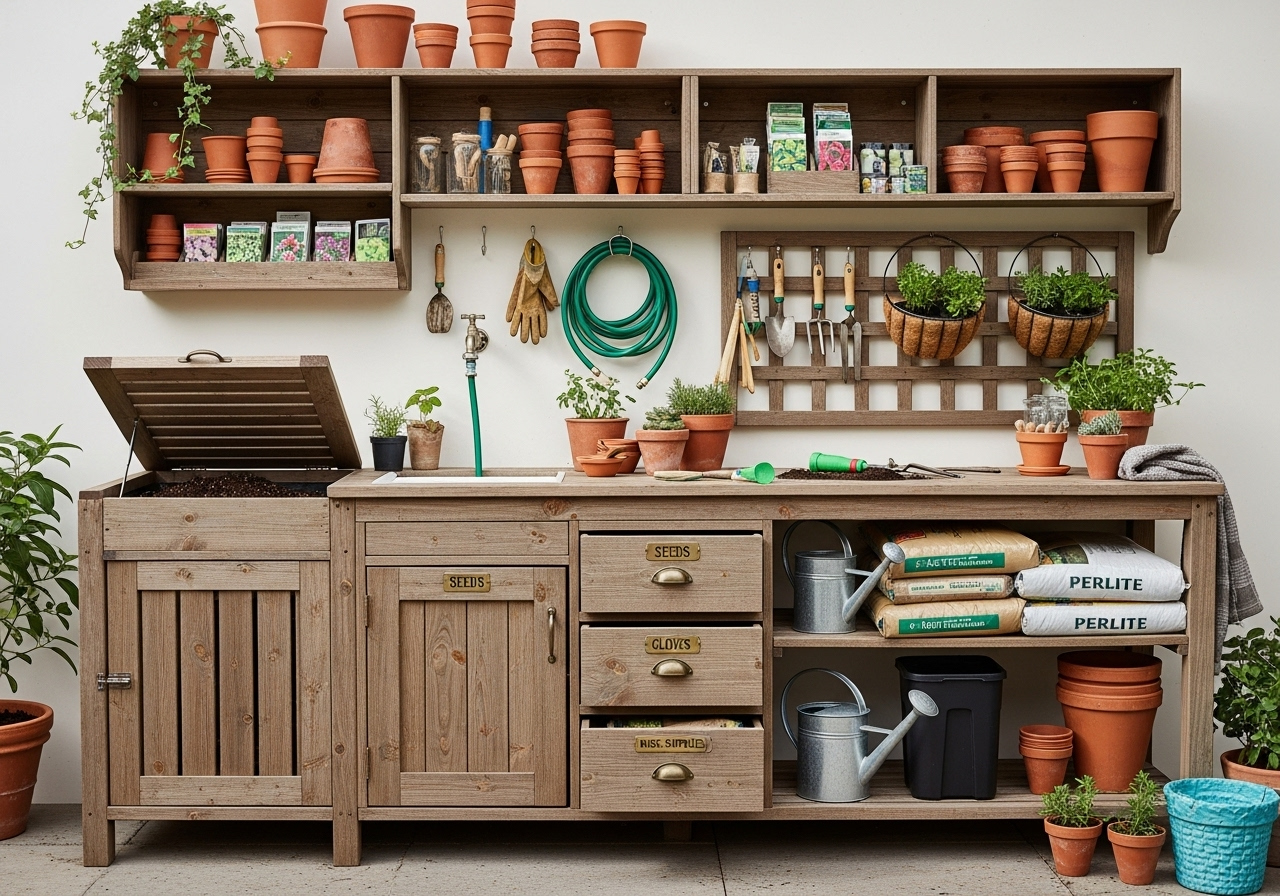
Shelving and Cabinets
The user will need shelves and cabinets to keep gardening tools, pots, soil, and other materials. Cabinets are essential for organizing gardening tools, pots, soil, and other supplies.
- Open Shelving: Perfect for storing commonly used items like fertilizers, plant pots or watering cans while being able to see and access them easily.
- Closed Cabinets: Ideal for keeping smaller contents secure and out of sight, like seeds, gloves, or cleaning supplies.
- Adjustable Shelves: Offer flexibility for various sized products, making the storage more versatile to changing storage needs.
Drawers and Hooks
- Drawers: Ideal for storing small tools, gloves, and hand trowels. They ensure the workspace remains uncluttered and that nothing gets misplaced.
- Hooks: Hooks on either side of the bench to hang tools such as shovels, rakes or hoses. This maximizes the vertical space and makes sure that tools are accessible and can be quickly returned to their place.
- Pegboards: Attach a pegboard with hooks to the back or side of a potting bench for extra vertical storage of hanging tools.
Composting and Watering Stations
- Built-In Composting: Many potting benches feature a readily accessible composting area that gardeners can use for organic disposal. This is especially helpful to those who wish to do waste recycling and have a clean work area.
- Watering Stations: A watering system, like a hose connection or a trough of water, can make it much easier to water the plants. Others have a sink or drainboard for washing tools and containers, turning the potting bench into an even more useful element of the garden.
Utilizing Vertical Space
- Tall Storage: Maximize the space around the potting bench by adding some height with tall shelving units or cupboards. This adds more storage space without using excess floor space (especially in smaller gardens or apartments).
- Overhead Storage: Place shelves or a hanging storage rack above the potting bench for larger and less often-used supplies, like bags of soil or plant food.
- Wall-Mounted Bins or Containers: Place smaller gardening supplies, like seeds, gloves, or labels, into small bins or containers that can be wall-mounted for easy access and organization.
ℹ
Organizing Pots, Soil, and Gardening Supplies
- Stackable Bins: Stackable bins or baskets work great for keeping bags of soil, plant food, or other items together. With individual bins, users can see what’s inside at a glance.
- Pots and Planters: Keep additional pots and planters organized by storing them on shelves or in drawers. A tiered shelving system can showcase pots of various sizes and shapes, ensuring you can grab the right one when needed.
- Soil Storage: A dedicated spot for storing soil, like a large pot or box, reduces mess. A sturdy container with a lid helps keep dirt dry and ready to use, safe from outdoor elements.
How to Set Up the Potting Bench
An outdoor potting bench with sink can be one of the most exciting features of the garden, just not only the garden service.
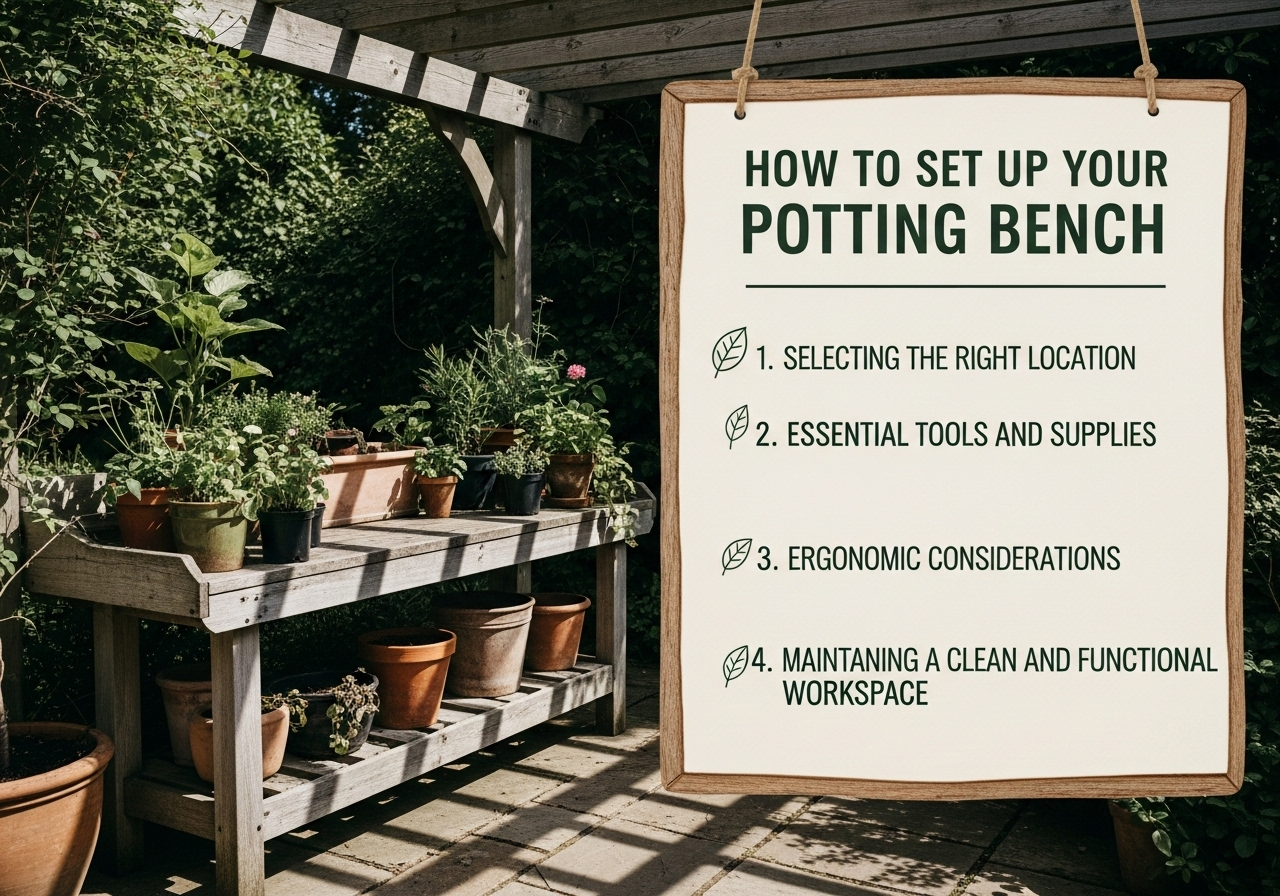
1. Selecting the Right Location
Outdoor potting benches are great for gardeners who have an open-area garden or any type of backyard. These benches should be located in a good light, in proximity to a water source for watering and cleaning. It’s also a good idea to avoid placing the bench in strong winds or direct sun exposure, which can wear out the materials.
Indoor potting stations, however, are ideal for small-space gardeners or anyone who enjoys working indoors. Put these benches in a natural light location (like by a window) out of high-traffic areas. For convenience, an indoor station can be installed in a garage, balcony or extra room.
2. Essential Tools and Supplies
The following must-have tools and supplies to have in a well-equipped potting bench are:
- Hand trowel: For digging and moving soil.
- Pruning shears: Essential for trimming plants.
- Watering can or hose: For keeping plants hydrated.
- Pots and planters: Various sizes for repotting and planting.
- Soil and fertilizers: Ensure a steady supply of soil and plant food.
- Gloves: To protect hands while working with soil and plants.
- Plant markers: To label different plants and seeds.
3. Ergonomic Considerations
Select a potting bench that will provide comfort and efficiency thanks to an ergonomic height to fit the working style. The table must be at waist level so the user can be comfortable and work with straining or bending and the user can keep right on working at tabletop level. If going to be working for longer periods of time, then a work bench that can be adjusted for height and even a stool will save the knees and back.
4. Maintaining a Clean and Functional Workspace
An organized potting bench also increases productivity and safety. Tools are put into drawers, shelves, or hung on hooks to avoid a mess. Keep the surface clean with regular washing-off of any soil or water. Users can also try to fill them with trays or liners to contain the spills and dirt, for convenient cleaning. Frequent care maintains the work area's performance and availability.
Buying vs. DIY Potting Bench Ideas
If trying to figure out whether to make the potting bench yourself or buy one, there are many factors to consider, such as customization, cost, skill level, and how much time you want to devote to the project.
Aspect | Building Your Own | Buying Pre-Made |
Customization | Full customization of size, style, and features. Tailor to specific needs. | Limited customization; you choose from available models. |
Cost | Generally cheaper if you have materials or tools. Costs range from $50 to $200. | Can range from $100 to $300+, depending on size and features. |
Time Commitment | Time-consuming, especially for beginners. Can take from hours to days. | Immediate setup; no time needed for construction. |
Skill Level | Requires basic carpentry skills. Mistakes can lead to extra costs or delays. | No skill required, but limited flexibility in design. |
Tools & Equipment | Need access to tools such as saws, drills, etc. The cost of tools may add up. | No tools required; ready to use out of the box. |
Satisfaction | Sense of accomplishment from building it yourself. | No personal involvement in creation, just purchasing. |
Potting Station Organization Tips
Caring for the potting bench is key to helping it to continue to serve well and last for many years, adding convenience and fun to the gardening experience. Here are some tips on maintenance to ensure the potting bench remains in the best condition.
Regular Cleaning and Upkeep
- Clean After Each Use: You would need a potting bench that is easy to clean off of water, soil, and plant gunk. Wipe clean with this soft damp cloth with a little bit of soap and you can avoid any buildup of dirt.
- Check for Clutter: Get in the habit of regularly decluttering the bench. Storage spots, like shelves and drawers, need to be checked for organization on a regular basis.
- Inspect for Damage: Regular inspections should be made for any damages which may be visible in the form of cracks or loose screws. All repairs should be made as soon as possible to keep the bench in serviceable condition.
Protecting Wood Surfaces
- Seal the Wood: If the potting bench is outside, you need to protect the wood from the weather. Some sort of waterproofing should be used to avoid unsightly water damage.
- Use Protective Covers: Always cover the outdoor work table with dry towels or a tarp to shield it from rain, snow, and harmful UV rays, prevent fading, cracking, and warping.
- Treating for Pests: If you built a wood potting bench, it’s important to treat it with a pest repellent treatment that protects against wood-eating bugs and termites.
Seasonal Maintenance Tips
- Spring and Summer: In the warmer seasons, the bench is going to get a lot of use. It requires regular cleaning and the bench will need to dry thoroughly after watering of plants. Add an additional protective coat to shield the bench from water damage and sun exposure.
- Fall and Winter: If used for outdoor potters benches, storage inside during the colder months is recommended. Failing that, the bench should be sufficiently protected with coverage, or placed in a sheltered location to prevent damage from snow or rain.
- Indoor Benches: Indoor potting stations should be cleaned after each use all year long, but take special care in winter to avoid sitting water, which may be conducive to mold or mildew.
FAQs
What are the benefits of a potting bench for indoor gardening?
When gardening indoors, a potting bench gives a neat, organized work space for things like planting herbs or small plants. It enables year-round planters even during inclement weather, featuring compact designs that are ideal for small interior spaces such as balconies, kitchens, or spare rooms.
What materials are best for outdoor potting benches?
When it comes to outdoor potting benches, wood (think cedar or redwood) is a favorite for its natural appearance and sturdiness. A metal bench, like a stainless steel bench, is also long-lasting and resistant to the elements. It’s also critical that the materials are weatherproofed to resist moisture, sunlight damage, and being eaten by pests.
How do I maintain my potting bench for long-term use?
Keep the surface free from soil and debris. Outdoor benches should be treated regularly with weather-proof sealants and have protective covers. Check for any damages and fix all the loose screws and cracks to continue with serving its purpose.
Summary
A potting bench is a must-have tool for any gardener, providing a designated area to complete tasks such as potting plants, planting seeds, and storing tools. With features like a durable work surface, storage shelf and height, a potting bench is convenient for gardening and very practical. Whether crafting a potting bench yourself or buying a pre-made one, these raise considerations such as personal customization, cost, and how much time and skill the project will require.
For those in search of gardening supplies and accessories, Growcycle is a great source. It has different product selections that will make any gardener's experience better with everything from potting benches to numerous other tools.
Disclaimer: This material is for informational purposes only and should not be relied on for legal, medical, financial, or any other form of professional advice.
About the Author
Environmental Journalist Focused on Sustainable Agriculture
Victor Miller is an environmental journalist at Growcycle, specializing in sustainable agriculture. With a passion for storytelling, he highlights the latest trends, innovations, and practices that promote ecological balance and responsible farming.
